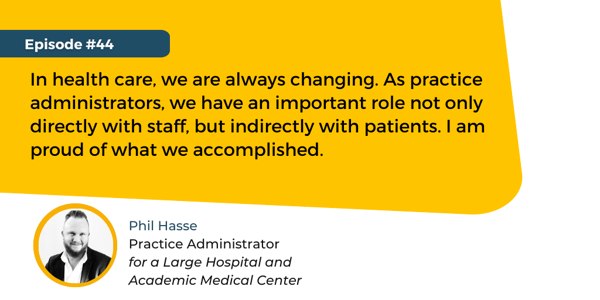Episode Overview:
In this episode of Value-Based Care Insights, Daniel J. Marino speaks with Phil Hasse to discuss the real-life implications of COVID on medical practices. Hasse shares his insights on how operations have changed drastically since COVID and how hospitals are managing now. They also explore the impact of physicians, revenue, patients, and the business practice of medicine as health care navigates through COVID.
Host:

Daniel J. Marino, Managing Partner, Lumina Health Partners
Guest:

Phil Hasse, Practice Administrator for a Large Hospital and Academic Medical Center
Episode Discussion Areas:
1. COVID and post-COVID: How things rapidly evolved.
-
- Implemented telehealth solutions.
- Developed a more streamlined operational process of patient flow.
- Primary care bore the brunt of burnout. Administrators and patients are also burned out.
2. Operational changes and outcomes.
-
- Each of the offices is run like their own business.
- No staff reductions.
- Referral requests.
- Robust check-in process.
- Designed smaller offices with closed doors.
3. Financial impacts.
-
- Payer reimbursement has declined.
- Budget and spending was evaluated.
- Pediatricians were hit the hardest.
- Mid-summer, there have been rebounds — primary care.

7 Key Takeaways: Medical Practice Operations: Enhancing Care Delivery Post-COVID
- What were some of the biggest challenges for the practice during COVID?
Patient volumes, care delivery and communication changed because COVID changed things often. - Telehealth adoption.
A large practice had the goal of adding 29 physicians to telehealth by the end of 2020 — they had no idea the whole system would go telehealth in essentially one day. The entire team immediately developed a plan and became a well-oiled machine due to COVID. - Workforce management.
Staffing became a challenge — do we send employees home or keep them in? We didn’t realize how challenging it would be to bring patients back into the office. - Volumes are back above pre-COVID levels.
Over the summer, the organization slowly introduced patients back into the office and set goals for the percentages of in-person and telehealth visits. Televisits accelerated differently because of changes in reimbursement, but all offices are going live with influenza-like illness patients and getting back to normal. New protocols help triage patients and incorporate them into delivery models. - How have providers managed the pandemic?
In the beginning, everyone was a team player and focused on what to do next. But a lot of stressors are falling on physicians, and more burnout is apparent. - Workforce issues remain a focus.
Personnel is jumping ship to go to other organizations for sign-on bonuses. It’s a demotivator to see people leave, and vacancy rates are the highest they’ve ever been. Organizations are losing staff to competitors, including to non-health care competitors.
Creating a well-being committee can brainstorm ideas for reminding staff of how to keep themselves physically and mentally healthy and help them feel good about the work they’re doing. It’s a retention initiative. - Change is inevitable.
It’s important to stay ahead of that change, move forward, and plan for what changes might occur and what those impacts might be. Keeping a level head and staying positive is important, because perspective makes the difference between success and failure.

About Value-Based Care Insights Podcast
Value-Based Care Insights is a podcast that explores how to optimize the performance of programs to meet the demands of an increasing value-based care payment environment. Hosted by Daniel J. Marino, the VBCI podcast highlights recognized experts in the field and within Lumina Health Partners.




Share this: